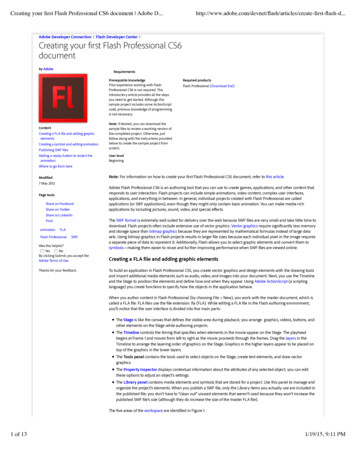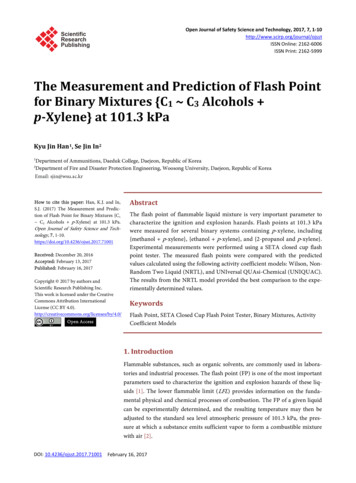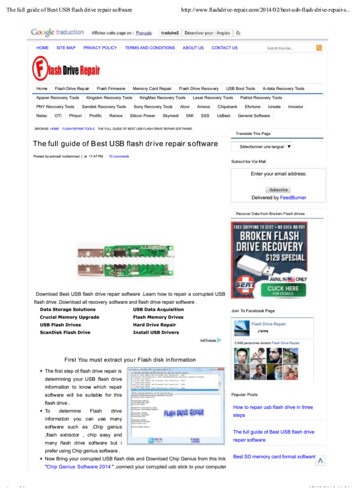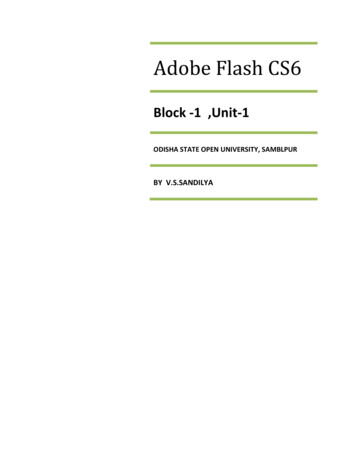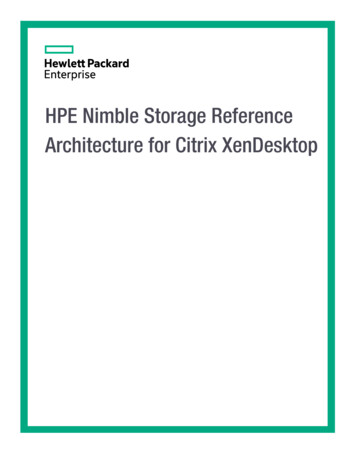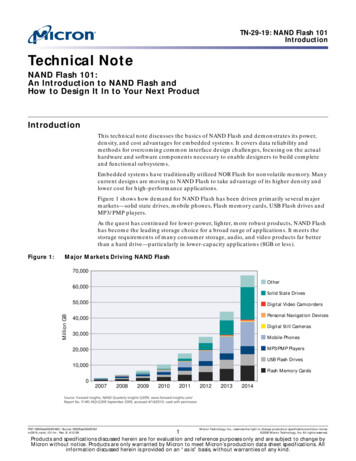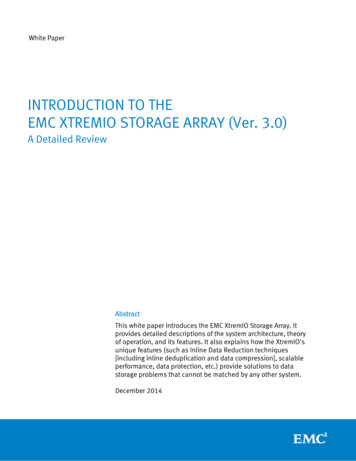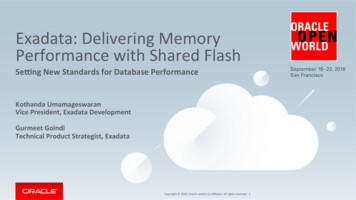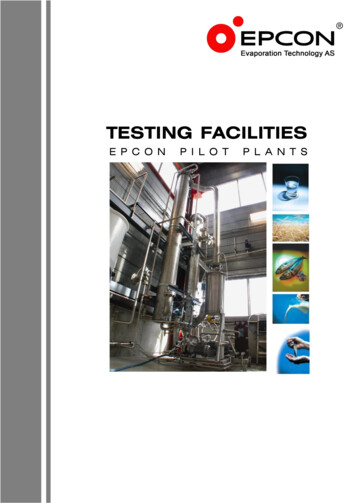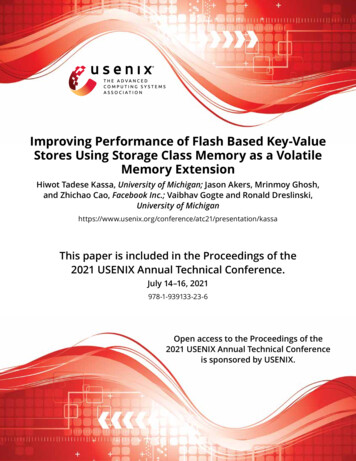
Transcription
Improving Performance of Flash Based Key-ValueStores Using Storage Class Memory as a VolatileMemory ExtensionHiwot Tadese Kassa, University of Michigan; Jason Akers, Mrinmoy Ghosh,and Zhichao Cao, Facebook Inc.; Vaibhav Gogte and Ronald Dreslinski,University of esentation/kassaThis paper is included in the Proceedings of the2021 USENIX Annual Technical Conference.July 14–16, 2021978-1-939133-23-6Open access to the Proceedings of the2021 USENIX Annual Technical Conferenceis sponsored by USENIX.
Improving Performance of Flash Based Key-Value Stores Using Storage ClassMemory as a Volatile Memory ExtensionHiwot Tadese KassaUniversity of MichiganJason AkersFacebook, Inc.Vaibhav GogteUniversity of MichiganAbstractHigh-performance flash-based key-value stores in datacenters utilize large amounts of DRAM to cache hot data.However, motivated by the high cost and power consumptionof DRAM, server designs with lower DRAM per computeratios are becoming popular. These low-cost servers enablescale-out services by reducing server workload densities. Thisresults in improvements to overall service reliability, leadingto a decrease in the total cost of ownership (TCO) for scalable workloads. Nevertheless, for key-value stores with largememory footprints these reduced DRAM servers degrade performance due to an increase in both IO utilization and dataaccess latency. In this scenario a standard practice to improveperformance for sharded databases is to reduce the numberof shards per machine, which degrades the TCO benefits ofreduced DRAM low-cost servers. In this work, we explore apractical solution to improve performance and reduce costsof key-value stores running on DRAM constrained servers byusing Storage Class Memories (SCM).SCM in a DIMM form factor, although slower than DRAM,are sufficiently faster than flash when serving as a large extension to DRAM. In this paper, we use Intel Optane PMem 100 Series SCMs (DCPMM) in AppDirect mode toextend the available memory of RocksDB, one of the largestkey-value stores at Facebook. We first designed hybrid cachein RocksDB to harness both DRAM and SCM hierarchically.We then characterized the performance of the hybrid cachefor 3 of the largest RocksDB use cases at Facebook (WhatsApp, Tectonic Metadata, and Laser). Our results demonstratethat we can achieve up to 80% improvement in throughputand 20% improvement in P95 latency over the existing smallDRAM single-socket platform, while maintaining a 43-48%cost improvement over the large DRAM dual socket platform.To the best of our knowledge, this is the first study of theDCPMM platform in a commercial data center.1IntroductionHigh-performance storage servers at Facebook come in twoflavors. The first, 2P server, has two sockets of compute anda large DRAM capacity as shown in Figure 1a and providesUSENIX AssociationMrinmoy GhoshFacebook, Inc.Zhichao CaoFacebook, Inc.Ronald DreslinskiUniversity of Michiganexcellent performance at the expense of high power and cost.In contrast, 1P server (Figure 1b), has one socket of computeand the DRAM-to-compute ratio is half of the 2P server.The advantages of 1P server are reduced cost, power, andincreased rack density [1]. For services with a small DRAMfootprint, 1P server is the obvious choice. A large number ofservices in Facebook fit in this category.However, a class of workloads that may not perform adequately on a reduced DRAM server and take advantage ofthe cost benefits of 1P server at Facebook are flash-basedkey-value stores. Many of these workloads use RocksDB [2]as their underlying storage engine. RocksDB utilizes DRAMfor caching frequently referenced data for faster access. Alow DRAM to storage capacity ratio for these workloads willlead to high DRAM cache misses, resulting in increased flashIO pressure, longer data access latency, and reduced overallapplication throughput. Flash-based key-value stores in Facebook are organized into shards. An approach to improve theperformance of each shard on DRAM constrained serversis to reduce the number of shards per server. However, thisapproach can lead to an increase in the total number of serversrequired, lower storage utilization per server, and dilutes theTCO benefits of the 1P server. This leaves us with the difficultdecision between 1P server, which is cost-effective while sacrificing performance, or 2P server with great performance athigh cost and power. An alternative solution that we explorein this paper is utilizing recent Intel Optane PMem 100Series SCMs (DCPMM) [3] to efficiently expand the volatilememory capacity for 1P server platforms. We use SCM tobuild new variants of the 1P server platforms as shown inFigure 1c. In 1P server variants, the memory capacity of 1Pserver is extended by providing large SCM DIMMs alongside DRAM on the same DDR and bus attached to the CPUmemory controller.Storage Class Memory (SCM) is a technology with theproperties of both DRAM and storage. SCMs in DIMM formfactor have been studied extensively in the past because oftheir attractive benefits including byte-addressability, datapersistence, cheaper cost/GB than DRAM, high density, andtheir relatively low power consumption. This led to abundant research focusing on the use cases of SCM as memory2021 USENIX Annual Technical Conference821
hDRAM hitsCPUCPUCPULess IOutilizationsIOcontrollerLowDRAM hitsSSDHigh IOutilizationsSSDDRAMDRAM(a) 2P server.(b) 1P server.High SCM hitsto large colddataMemorycontrollerIOcontrollerHigh DRAM hitsto hot dataLess IOutilizationsSCMSSDDRAM(c) 1P server variant.Figure 1: Server configurations with different DRAM sizes: (a) Server with 256GB memory, high hit rate to DRAM and low IO utilization (b) Server withreduced (64GB) memory, lower DRAM hit rate and increased in IO utilization and (c) Server with reduced memory and SCM added to the memory controller,high hit rate to DRAM & SCM due to optimized data placement, which decreases IO utilization.Table 1: Example of memory characteristics of DRAM, SCM andflash per module taken from product specifications.CharacteristicsIdle read latency (ns)Read bandwidth (GB/s)Power (mW / GB)DRAM RelativeCost per GBGranularityDevice Capacity 48and persistent storage. The works range from optimizationswith varying memory hierarchy configurations [4–8], novelprogramming models and libraries [9–11], and file system designs [12–14] to adopt this emerging technology. Past researchwas focused primarily on theoretical or simulated systems,but the recent release of DCPMM-enabled platforms fromIntel motivates studies based on production-ready platforms[15–24]. The memory characteristics of DRAM, DCPMM,and flash are shown in Table 1. Even though DCPMM hashigher access latency and lower bandwidth than DRAM ithas a much larger density and lower cost, and its access latency is two orders of magnitude lower than flash. Currently,DCPMM modules come in 128GB, 256GB, and 512GB capacities, much larger than DRAM that typically ranges from4GB to 32GB in a data-center environment. Hence we can geta tremendously larger density with DCPMM. If we efficiently(cost and performance) use this memory as an extension toDRAM, this would enable us to build dense, flexible, serverswith large memory and storage, while using fewer DIMMsand lowering the total cost of ownership (TCO).Although recent works demonstrated the characteristicsof SCM [15, 18], the performance gain achieved in largecommercial data-centers by utilizing SCM remains unanswered. There are open questions on how to efficiently configure DRAM and SCM to benefit large scale service deployments in terms of cost/performance. Discovering the usecases within a large scale deployment that profit from SCMhas also been challenging. To address these challenges forRocksDB, we first profiled all flashed-based KV store deployments at Facebook to identify where SCM fits in ourenvironment. These studies revealed that we have abundant8222021 USENIX Annual Technical Conferenceread-dominated workloads, which focused our design effortson better read performance. This has also been established inprevious work [25–27] where faster reads improved overallperformance for workloads serving billions of reads everysecond. Then, we identified the largest memory consumingcomponent of RocksDB, the block cache used for servingread requests, and redesigned it to implement a hybrid tieredcache that leverages the latency difference of DRAM andSCM. In the hybrid cache, DRAM serves as the first tier cacheaccommodating frequently accessed data for fastest read access, while SCM serves as a large second tier cache to storeless frequently accessed data. Then, we implemented cacheadmission and memory allocation policies that manage thedata transfer between DRAM and SCM. To evaluate the tieredcache implementations we characterize three large productionRocksDB use cases at Facebook using the methods describedin [28] and distilled the data into new benchmark profiles fordb bench [29]. Our results show that we can achieve 80%improvement to throughput, 20% improvement in P95 latency,and 43-48% reduction in cost for these workloads when weadd SCM to existing server configurations. In summary, wemake the following contributions: We characterized real production workloads, identifiedthe most benefiting SCM use case in our environment,and developed new db bench profiles for accuratelybenchmarking RocksDB performance improvement. We designed and implemented a new hybrid tiered cachemodule in RocksDB that can manage DRAM and SCMbased caches hierarchically, based on the characteristicsof these memories. We implemented three admissionpolicies for handling data transfer between DRAM andSCM cache to efficiently utilize both memories. Thisimplementation will enable any application that usesRocksDB as its KV Store back-end to be able to easilyuse DCPMM. We evaluated our cache implementations on a newly released DCPMM platform, using commercial data centerworkloads. We compared different DRAM/SCM sizeserver configurations and determined the cost and per-USENIX Association
formance of each configuration compared to existingproduction platforms. We were able to match the performance of large DRAMfootprint servers using small DRAM and additional SCMwhile decreasing the TCO of read dominated services inproduction environment.The rest of the paper proceeds as follows. In Section 2 weprovide a background of RocksDB, the DCPMM hardwareplatforms, and brief description of our workloads. Sections 3and 4 explain the designs and implementation of the hybridcache we developed. In Section 5 we explain the configurations of our systems and the experimental setup. Our experimental evaluations and results are provided in Section 6. Wethen discuss future directions and related works in Section 7and Section 8 respectively, and conclude in Section 9.2Background2.1RocksDB architectureMEMORY MODEAPP DIRECT MODEAPPLICATIONAPPLICATIONDRAM AS CACHEDRAMOPTANE MEMORYOPTANE MEMORYFigure 2: Intel Optane memory operation modes overview.Therefore, in this work we optimize the RocksDB using SCMas volatile memory for the Block Cache.2.1.2 Benchmarking RocksDBOne of the main tools to benchmark RocksDB is db bench[29]. Db bench allows us to mock production RocksDB runsby providing features such as multiple databases, multiplereaders, and different key-value distributions. Recent work[28] has shown how we can create realistic db bench workloads from production workloads. To create evaluation benchmarks for SCM we followed the procedures given in [28, 35].2.2Intel Optane DC Persistent MemoryA Key-value database is a storage mechanism that uses keyvalue pairs to store data where the key uniquely identifiesvalues stored in the database. The high performance and scalability of key-value databases promote their widespread usein large data centers [2, 30–32]. RocksDB is a log-structuredmerge [33] key-value store engine developed based on theimplementation of LevelDB [30]. RocksDB is an industrystandard for high performance key-value stores [34]. At Facebook RocksDB is used as the storage engine for several datastorage services.Intel Optane DC Persistent Memory based on 3D XPointtechnology [36, 37], is the first commercially available nonvolatile memory in the DIMM form factor and resides onthe same DDR bus as DRAM [3]. DCPMM provides byteaddressable access granularity which differentiates it fromsimilar technologies which were limited to larger block-basedaccesses. This creates new opportunities for low latency SCMusage in data centers as either a volatile memory extension toDRAM or as a low latency persistent storage media.2.1.1DCPMM can be configured to operate in one of two differentmodes: Memory Mode and App Direct Mode [38]. Illustrations of the modes are shown in Figure 2.In Memory Mode, as shown in Figure 2, the DRAM capacity is hidden from applications and serves as a cache forthe most frequently accessed addresses, while DCPMM capacity is exposed as a single large volatile memory region.Management of the DRAM cache and access to the DCPMMis handled exclusively by the CPU’s memory controller. Inthis mode applications have no control of where their memoryallocations are physically placed (DRAM cache or DCPMM).In App Direct Mode, DRAM and DCPMM will be configured as two distinct memories in the system and are exposedseparately to the application and operating system. In thiscase, the application and OS have full control of read andwrite accesses to each media. In this mode, DCPMM can beconfigured as block-based storage with legacy file systemsor can be directly accessed (via DAX) by applications usingmemory-mapped files.RocksDB components and memory usageRocksDB stores key-value pairs in a Sorted String Table(SST) format. Adjacent key-value data in SST files are partitioned into data blocks. Other than the data block, each SSTfiles contains Index and Filter blocks that help to facilitateefficient lookups in the database. SST files are organized inlevels, for example, Level0 - LevelN, where each level comprises multiple SST files. Write operations in RocksDB firstgo to an in-memory write buffer residing in DRAM calledthe memtable. When the buffered data size in the memtablereaches a preset size limit RocksDB flushes recent writes toSST files in the lowest level (Level0). Similarly, when Level0exhausts its size limit, its SST files are merged with SST fileswith overlapping key-values in the next level and so on. Thisprocess is called compaction. Data blocks, and optionally,index and filter blocks are cached (typically uncompressed) inan in-memory component called the Block Cache that servesread requests from RocksDB. The size of the Block Cacheis managed by global RocksDB parameters. Reads from thedatabase are attempted to be serviced first from the memtable,then next from the Block Cache(s) in DRAM, and finally fromthe SST files if the key is not found in memory. Further detailsabout Rocksdb are found in [2]. The largest use of memoryin RocksDB comes from the Block Cache, used for reads.USENIX Association2.2.12.3Operation mode overviewFacebook RocksDB workloadsFor our experiments and evaluation we chose the largestRocksDB use cases at Facebook, which demonstrate typicaluses of key-value storage ranging from messaging services to2021 USENIX Annual Technical Conference823
33.1Hybrid cache design choicesThe challenges of SCM deploymentThe first challenge of introducing SCM in RocksDB is identifying which of its components to map to SCM. We chose theuncompressed block cache because it has the largest memoryusage in our RocksDB workloads and because our studiesreveal that a number of our production workloads, which areread-dominated, benefit from optimizing read operations byblock cache extension. We also focused on the uncompressedblock cache instead of the compressed ones, so that we canminimize CPU utilization increase when performing compression/decompression. This allowed us to increase the sizeof SCM (block cache) without requiring additional CPU resources. We also chose block cache over memtable becauseSCM provides better read bandwidth than writes, hence helping our read-demanding workloads. We then expanded theblock cache size by utilizing SCM as volatile memory. Wechose this approach because extending the memory capacitywhile reducing the size of DRAM and the cost of our serversis the primary goal. Although we can benefit from persistingblock cache and memtable in SCM for fast cache warmupand fast write access, we left this for future work.The next challenge is, how we should configure SCM to getthe best performance. We have the options of using memorymode, that does not require software architecture changes orapp-direct mode that necessitates modification in RocksDBbut provides control of DRAM and SCM usage. Figure 3demonstrates how memory-mode compares to our optimizedapp-direct mode. Optimized app-direct mode with variousDRAM and SCM sizes, renders 20-60% throughput improvement and 14-49% lower latency compared with memory mode.This insight supports that our optimized implementation has8242021 USENIX Annual Technical ConferenceApp-direct P95 latencyrelative to Memory modeOptimized App-directthroughput relative toMemory mode21.510.5010.5032 - 6432 - 128 32 - 256DRAM (GB) - SCM(GB)32 - 6432 - 128 32 - 256DRAM (GB) - SCM(GB)(a)(b)Figure 3: Throughput and latency comparison for memory mode andour optimized hybrid-cache in app-direct mode for WhatsApp.2Optimized App-directthroughput relative to naiveSCM block cacheDRAM block cachethroughput relative to SCMblock cachelarge storage for processing realtime data and metadata. Notethan these are not the only workloads that benefit from ourdesigns. The descriptions of the services are as follows:WhatsApp: With over a billion active users, WhatsApp isone of the most popular messaging applications in the world[39]. WhatsApp utilizes ZippyDB as its remote data store.ZippyDB [40] is a distributed KV-store that implements Paxoson top of RocksDB to achieve data reliability and persistence.Tectonic Metadata: The Tectonic Metadata databases arealso stored in ZippyDB and are an integral part of the largeblob storage service of Facebook that serves billions of photos,videos, documents, traces, heap dumps, and source code [41,42]. Tectonic Metadata maintains the mappings between filenames, data blocks and parity blocks, and the storage nodesthat hold the actual blocks. These databases are distributedand fault-tolerant.Laser: Laser is a high query throughput, low (millisecond) latency, peta-byte scale key-value storage service built on top ofRocksDB [43]. Laser reads from any category of Facebook’sreal-time data aggregation services [44] in real-time or froma Hadoop Distributed File System [45] table daily.1.510.5064128256Block cache size(a)21.510.5032 - 6432 - 128 32 - 256DRAM (GB) - SCM(GB)(b)Figure 4: (a) Throughput of DRAM vs SCM based block cache. (b)Throughput of naive SCM vs optimized hybrid-cache for WhatsApp.a better caching mechanism than memory mode, hence wefocused our analysis on app-direct mode.With app-direct we can manage the allocation ofRocksDB’s components (memtable, data, filter, and indexblocks) to DRAM or SCM. But since we know the data access latency of SCM is slower than DRAM (see Table 1), wehave to consider its effect. We compared the throughput ofallocating the block cache to DRAM or SCM in app-directmode in vanilla RocksDB to understand the impact of thehigher SCM access latency. As seen in Figure 4a, the slowerSCM latency creates 13%-57% difference in throughput whenwe compare DRAM based block cache to a naive SCM blockcache using app-direct mode. This result guided us to carefully utilize DRAM and SCM in our designs. In single-socketmachines such as 1P servers, we have one CPU and 32GB 64GB DRAM capacity. Out of this DRAM, memtable, index,and filter blocks consume 10-15 GBs. The rest of DRAMand the additional SCM can be allocated for block cache. Wecompared the naive SCM block cache implementation (allblock cache allocated to SCM using app-direct) to a smarterand optimized hybrid cache, where highly accessed data isallocated in DRAM and the least frequently access in SCM.The results in Figure 4b show with optimized app-direct weachieve up to 45% better throughput compared to a naiveSCM block cache. From this, we can determine that implementing a hybrid cache compensates for the performance lossdue to the higher SCM access latency. These results togetherwith the high temporal locality of our workloads (as discussedbelow) motivated us to investigate a hybrid cache.3.2RocksDB workload characteristicsBelow we scrutinize the characteristics of our largestRocksDB workloads that guided our hybrid cache design.USENIX Association
Throughput/cost of 32-256relative to 64 - 010.50WhatsApp TectonicMetadataLaserFeed21.510.5WhatsApp TectonicMetadataLaserFeed(b)(a)Figure 5: (a) Read to write ratio to DB. (b) Key-value throughput/cost compare for large block cache friendly workloads and Feedwith higher writes than reads.WhatsAppTectonic MetadataLaser1% access countDB read/write ratio21.50.80.60.40.2010 20 30 40 50 60 70 80 90 100% of accessed keysFigure 6: Key-value locality.Reads and writes to DB: As we discussed earlier, prior workshowed that optimizing reads provides large impact in commercial data center workloads [25–27]. Our studies also showthat we have a large number of read-dominated workloads,therefore optimizing the block cache, used for storing datafor fast read access, will benefit a number of our workloads.In RocksDB, when a key is updated in memtable it will beinvalid in the block cache. Hence, if the workload has morewrite queries than reads, then the data in the cache will become stale. Note that write-dominated workloads won’t beaffected by our hybrid cache designs because we did notreduce any DRAM buffer (memtable) in the write path. Inour studies, we profiled deployed RocksDB workloads for24 hours using an internal metrics collection tool to comprehend the read and write characteristics. Figure 5a shows theworkloads described in Section 2.3 reads more bytes fromthe DB than it writes. To contrast, we evaluated one of ourwrite-dominated workloads, Feed, also seen in Figure 5a. InFigure 5b, we calculated the throughput per cost of 1P servervariants with 32 GB DRAM and 256 GB SCM capacity normalized to throughput/cost of 1P server with 64 GB DRAMcapacity. The throughput/cost improvement of Feed for ourlargest DRAM-SCM system cannot offset the additional costdue of SCM. Hence, we focus on exporting read-dominatedworkloads to our hybrid systems.Key-value temporal locality: Locality determines thecacheability of block data given a limited cache size. A hybridcache with a small DRAM size will only benefit us if we havea high temporal locality in the workloads. In this case, significant access to the block cache will come from the DRAMcache, and SCM will hold the bulk of less frequently accessedblocks. We used RocksDB trace analyzer [35] to investigateup to 24 hours query statistics of workloads running on production 2P server and evaluate locality as the distributionUSENIX Associationof the total database access counts to the total keys accessedper database. Figure 6 shows that our workloads possess apower-law relationship [46] between the number of key-valuepair access counts and the number of keys accessed. We canobserve in the figure that 10% of the key-value pairs carry 50% of the key-value accesses. This makes a hybrid cachedesign with small DRAM practical for deployment.DB and cache sizes: The desirable DRAM and SCM cachesizes required to capture workload’s locality is proportionalto the size of the DB. Workloads with high key-value localityand large DB sizes can achieve a high cache hit rate withlimited cache sizes. But as the locality decreases for large DBsizes, the required cache sizes will grow. In the extreme caseof random key-value accesses, all blocks will have similarheat, diluting the value of the DRAM cache and reducingoverall hybrid cache performance asymptotically toward thatof the SCM-only block cache. For small DBs, locality mightnot play a significant role because the majority of the DBaccesses fit in a small cache. Such types of workloads will notbe severely affected by DRAM size reduction, and choosingthe 1P server variants with large SCM capacity will be awaste of resources. In our studies, after looking at variousworkloads in production, we choose our hybrid DRAM-SCMcache configuration to accommodate several workloads withlarger DB sizes ( 2TB total KVstorage per server).4DRAM-SCM hybrid cache moduleIn our RocksDB deployment, we placed the memtables, index blocks, and filter blocks in DRAM. We then designed anew hybrid cache module that allocates the block cache inDRAM and SCM. The database SST files and logs are locatedin Flash. The overview of RocksDB components allocationin the memory system is shown in Figure 7a. Our goal indesigning the new hybrid cache module is to utilize DRAMand SCM hierarchically based on their read access latencyand bandwidth characteristics. In our design, we aim to placehot blocks in DRAM for the lowest latency data access, andcolder blocks in SCM as a second tier. The dense SCM basedhybrid block cache provides a larger effective capacity thanpractical with DRAM alone leading to higher cache hit rates.This dramatically decreases IO bandwidth requirements tothe SST files on slower underlying flash media.The block cache is an integral data structure that is completely managed by RocksDB. Similarly, in our implementations, the new hybrid cache module is fully managed byRocksDB. This module then is an interface between RocksDBand the DRAM and SCM block caches, and fully managesthe caches’ operations. The overall architecture of the hybrid cache is shown in Figure 7c. The details of its internalcomponents are as follows:4.1Block cache listsThe hybrid cache is a new top-level module in RocksDB thatmaintains a list of underlying block caches in different tiers.2021 USENIX Annual Technical Conference825
DRAMSCMMemtablesIndex, filterblocksBlock cacheBlock cacheBlock cache listsSCM cacheDRAM cacheHashtableConfigsKey1Key2BlockBlockMeta RefsMeta RefsHashtableConfigsKey1Key2BlockBlockMeta RefsMeta RefsFlashSST files(a) Memory allocation of RocksDB components to hybrid DRAM-SCM cache.KV pair 1 KV pair 2HelperfunctionsLogKV pair NLRU listsCache admissionpolicies(b) Data block structure.Hybrid cacheconfigsHelperfunctionsLRU listsBlock cache operationsmanagement(c) Hybrid tier cache component and architecture.Figure 7: RocksDB components and memory allocation.The list of caches are extended from the existing RocksDBblock cache with LRU replacement policy. Note that in ourimplementations we have DRAM and SCM cache, but themodule can manage more than these two caches such asmultiple DRAM and SCM caches in a complex hierarchy.4.1.1Block cache architecture and componentsThe internal structures of DRAM and SCM caches, whichare both derived from the block cache, are shown in Figure7c. The block cache storage is divided into cache entries andtracked in a hashtable. Each cache entry holds a key, datablock, metadata such as key size, hash, current cache usage,and a reference count of the cache entry outside of the blockcache. The data block is composed of multiple key-valuepairs as shown in Figure 7b. Binary searches are performedto find a key-value pair in a data block. The data block sizeis configurable in RocksDB. In our case, the optimal sizewas 16KB. As the number of index blocks decreases we canincrease the data block size. As a result, with 16KB we wereable to reduce the number of index blocks making room fordata blocks within our limited DRAM capacity. Every blockcache has configs that are configured externally. This includessize, a threshold for moving data, a pointer to all other cachesfor data movement, and the memory allocator for the cache.The cache maintains an LRU list that tracks cache entries inorder from most to least recently used. The helper functionsare used for incrementing references, checking against thereference threshold, transferring blocks from one cache toanother, checking size limits, and so on. For the componentslisted above we extended and modified RocksDB to supporttiered structure, different kinds of admission policies andwe designed new methodologies to enable data movementbetween different caches and to support memory allocationto different memory types.4.1.2 Data access in the block cacheA block is accessed by a number of external components to theblock cache, such as multiple reader clients of the RocksDBdatabase. The number of external referencers is tracked bythe reference count. Mapping to a block is created when it is8262021 USENIX Annual Technical Conferencereferenced externally, this will increment the reference count.Whereas when the referencer no longer needs a block, mapping is released, and the reference count is decremented. If ablock has zero external references, it will be in the hashtableand tracked by the LRU list. If a block gets referenced again,then it will be removed from the LRU list. Note that in theLRU list, newly released blocks with no external referencesare on the top of the LRU list as the most recently used blocks,and when blocks are evicted, the bottom least recently usedblocks are evicted first. The block cache is used for read-onlydata, hence it doesn’t deal with any dirty data management.Therefore, when transferring data between DRAM and SCMwe do not have to deal with dirty data.4.2Cache admission policiesIdentifying and retaining blocks in DRAM/SCM based ontheir access frequencies requires proactive management ofdata transfer between DRAM, SCM, and flash. Hence, wedeveloped the fo
that we can achieve up to 80% improvement in throughput and 20% improvement in P95 latency over the existing small DRAM single-socket platform, while maintaining a 43-48% cost improvement over the large DRAM dual socket platform. To the best of our knowledge, this is the first study of the D


